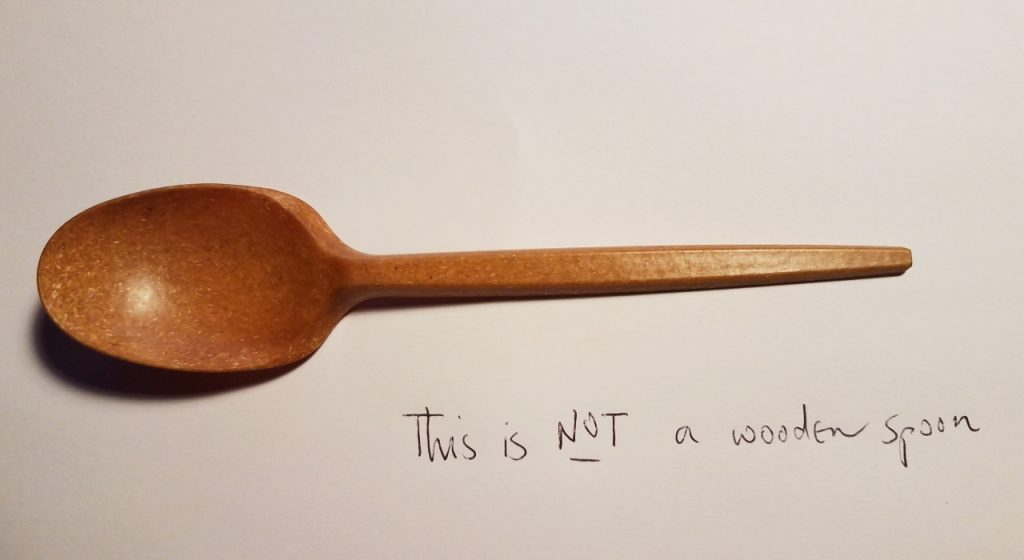Standing around a cocktail table during lunch at the 2019 Sustainability Science Days in Espoo last May, I and my new-found colleagues marvelled at the cutlery. The spoons were plastic but they had been designed to look and feel like wood. Together we thought it would be good to find a name for these plastic “wooden” spoons. “Greenwash” did not seem right as it was associated with corporate behaviour and we dispersed to the next session – on sustainability transitions – without managing to find the right term.
We should not have given up so easily. A few weeks ago I was at a luncheon seminar on the Paris Agreement at the Centre for International Environmental Studies in the Graduate Institute in Geneva and I found the same type of object. Unfortunately I must report that the Swiss plastic “wooden” spoons were actually better designed – more realistic – than the Finnish ones. Moreover – a nice touch this – for every twenty plastic spoons, there was actually a real wooden one. They all looked the same.
I would suggest that we call the plastic “wooden” spoon an ecological illusion. It looks ecological, contributing to sustainability, but in reality it is not.
I think ecological illusions are particular prevalent in the affluent world. They make us feel good. But in the end, in terms of planetary sustainability, they are a mirage in the desert.
Methodological Nationalism
Ecological illusions can take the form of physical objects like plastic “wooden” spoons. But they are far more insidious when they get hardwired into policy discourses about how to achieve planetary sustainability.
The speaker at the Graduate Institute argued that the Paris Agreement would fail because the emissions reduction targets required not simply the efforts of individual countries but also complementary international mechanisms. Such mechanisms had been thrown out with the demise of the Kyoto Protocol and it was necessary now to re-design them, and in particular to foster the international transfer of technology to developing countries.
It all made sense. However, the whole argument was based on graphs showing how rich countries were all reducing their emissions. They were on track. They had got through the hump of the environmental Kuznets curve. The climate change problem was now due to trends in the developing countries. They were the world’s biggest polluters.
Various participants pointed out, as we wielded our plastic “wooden” spoons, this picture depended on the way in which emissions were counted. The charts were based on territorial-based rather than consumption-based emissions accounting. In fact, the territorial-based approach shifts responsibility away from rich countries. It is another ecological illusion. How much of China’s emissions are related to its exports? How much of the EU’s good environmental record is due to displacement of ecological impacts to other countries?
Some complex methodological issues no doubt have to be addressed to ensure the reliability of consumption-based accounting. But lack of progress in this area, and also resistance to it, is rooted in a deeper source of illusion in eco-social theorizing, namely methodological nationalism.
I define this as a form of explanation in which national facts are explained by national factors. Essentially methodological nationalism delimits, to use Amartya Sen’s language, the “informational basis” of explanations by restricting the spatial frame through which the world is viewed. Factors outside the national frame, which may be either happenings in other countries or global institutional structures and systems, are regarded as having insignificant explanatory force.
Methodological nationalism gets instantiated and reinforced through such methods as territorial-based accounting, and it permeates our common sense worldviews. But it is untenable in an era of intense global interdependence. It is as if the part of the sky which one sees from the bottom of deep well is the whole sky.
UNEP’s sixth Global Environmental Outlook
I arrived at the Graduate Institute after listening, earlier in the morning, to the Geneva launch of UNEP’s sixth Global Environmental Outlook (GEO-6). For me, this 708-page document has less bite than earlier GEOs. For example, GEO-5, published in 2012, stated right up front that out of 90 environmental goals which had been internationally agreed since the Rio conference in 1992, significant progress had only been made on four. But what really shocked me in GEO-6 was another big ecological illusion.
The report organizes its encyclopaedic material into the so-called DPSIR framework – Drivers, Pressure, State (of the environment), Impact (on the environment and human well-being) and Responses – and it identifies five key Drivers of environmental impact: Population, Economic Development, Technology, Urbanization and Climate Change. This is an extended version of the well-known IPAT equation in which impact is driven by population, affluence and technology. But by replacing “affluence” by “economic development”, the Report lets rich countries off the hook. Who thinks of economic development as something happening in countries like UK, or Switzerland or Finland? No, this is something which happens in developing countries. Once again an ecological illusion is being created which shifts responsibility to developing countries through a semantic sleight of hand. It also misses the opportunity of dissolving North-South tensions by recognizing that it is the affluent in both the North and the South who are responsible for most environmental damage.
People should look at GEO-6 to form their own judgement. The speaker at the launch said it would be used as one of the key reports for what he said would be a Stockholm+50 Conference which was envisaged for 2022. But do not be tempted to take the short-cut of reading the summary for policy-makers. That document, it turns out, was negotiated by governments.
What, I asked, were the main areas of controversy in that negotiation? Well, there were two. Firstly, the policy-makers could not agree to recommend a shift to “meat-light diets”, despite GEO-6’s clear analysis of the role of meat production in environmental damage. Instead they recommended a shift to “healthy diets”. Secondly, the phrase “international transfer of technology” was a no-no. It actually does not appear in the policy-maker’s summary. Rather “Enhancing access to existing environmental technologies that are adapted to domestic circumstances could help countries to achieve environmental objectives more quickly”, is what got negotiated. The luncheon speaker’s solution – surely essential for planetary sustainability – was thus in the UNEP report summary what deep-fried sheep’s balls are known as in Greece, amelitita (“unmentionables”), and its repression was engendering further ecological illusions.
I now carry my plastic “wooden” spoon from Espoo with me everywhere.

Charles Gore
Charles Gore was a Visiting Scholar in Development Studies in the University of Helsinki from January to June 2019 and is currently an Honorary Professor in Economics at the University of Glasgow and a Research Associate in Global Studies at the University of Sussex. His research focuses on the nature of the explanations, normative judgements and discursive narratives which underpin international development practice.


An excellent commentary, thank you ! I am sure most of the readers could provide own examples of such illusions. In Finland, it would be for ex attempts of defining peat a renewable source of energy. Another most recent example of Methodological Nationalism is the ways many countries are trying too calculate the environmental impacts of their dairy and beef farming in order to show that their is best of all and should this excused from “the blame”
Spoon in picture seems like it’s from Akvila Nature Line
http://www.akvila.com/natureline/
“Akvila’s wood fibre cutlery has a (CO2) carbon footprint up to 80% lower than the ordinary fossil-based plastic cutlery and up to 60% lower than cutlery made from PLA. Akvila’s cutlery has lower ecological footprint than any other bio-based cutlery”
Thank you, Mikko, for this insight. I have looked at the cutlery on the link in your comment and I am sure you are right that the spoon which I was using in Espoo is from Akvila’s Nature Line.
I would also like to assure you that both I and my colleagues at that event thought that the spoon was plastic. Essentially what seemed to us to be a plastic “wooden” spoon was actually a wooden “plastic” spoon. That is to say, the spoon was designed to have the performance characteristics of plastic whilst being based on wood fibre. For us as consumers, it was still an ecological illusion – but a good one, promoting planetary sustainability, rather than a bad one, undermining it. There were no markings on the spoon itself to show that it was an ecological product, but perhaps they were on the package.
I am not sure what this implies for efforts to achieve a transition to sustainable consumption in affluent societies. Will such products play a key role?
Whatever the case, I am still convinced that there are bad ecological illusions blocking the path to planetary sustainability which are hard-wired in policy discourse. These are propagated, as I exemplified, through emissions accounting methods, methodological nationalism, analytical frames and key words.
I am also still going to carry my spoon from Espoo with me everywhere. It is good to think with, though you have shown me that it is a much more complex exemplar than I had initially imagined. .